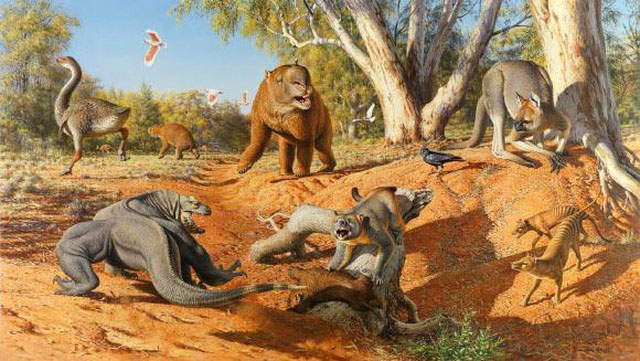Extreme climate extinct giant fauna in Australia and New Guinea
Extreme climate change is most likely responsible for the extinction of the giant animal system in the Sahul - the supercontinent created by Australia and New Guinea during low sea levels.
South Walker Creek , the youngest animal community in northern Australia, was once home to at least 16 species of large animals, including 13 extinct and three extant.

Giant fauna in Australia.
The large carnivorous animals are represented by swamp lions ( Thylacoleo ), at least three types of crocodiles ( Crocodylus porosus, Pallimnarchus sp. And Quinkana sp. ) And two giant lizard species ( Varanus priscus , also known as is Megalinia and a species the size of the Komodo dragon).
Large plant-eating animals include two species of koalas, one species of marsupial Parlochestid, two species of the two front teeth, the Australian desert ostrich ( Dromaius novaehollandiae ) and five species of kangaroos.
A kangaroo species once 2.5 meters tall and weighing an estimated 274 kg, these numbers make it the largest kangaroo species of all time.
Dr Scott Hocknull, a paleontologist at the Queensland Museum and University of Melbourne, said: 'The huge animal population at South Walker Creek was once a unique tropical region, dominated by reptiles. meat and giant herbivores became extinct about 40,000 years ago, soon after humans arrived in the Australian continent. '
While other parts of the world have gigantic predators like saber-tooth tigers, bears and hyenas, predators in Australia are mostly giant reptiles, including a fish. freshwater crocodile about 7 meters long extinct, it is related to saltwater crocodile and alligator live on land.
There are also two species of giant lizards including the 6 meter long lizard called Megalinia and another species similar in size to the Komodo dragon.

Giant animals come from the main fossil sites of South Walker Creek SW9, SWJ and SW3 with the downstream SWCC (indicated by the arrow)
The team cannot place humans at the scene of this 40,000-year-old crime because there is no solid evidence. Therefore, they failed to find a human role in the extinction of these giant animals, Dr. Hocknull said.
Instead, the team found that the extinction coincided with severe climatic and environmental changes in both local and regional settings, including increased fires and reduced grassland. and loss of fresh water. At the same time, all of these changes are maintained so much that the largest animals in Australia can cope.
The research was published in the journal Nature Communications.
- Newly discovered that the world's most rare and rare dog is still alive and well
- Why terrible forest fire in Australia?
- Discovered the rare and extinct bat species
- Extreme heat waves threaten to trigger Australian fires again
- Stunned with extremely rare giant banana varieties
- 1001 wondering: How much does the world's largest mouse weigh?
- The giant bird in Australia is extinct due to excessive hunting
- Great extinct Australian mammals
- Reveal the true cause of the mammoth extinction
- Siberian Unicorns are extinct due to climate change, not by humans
- Detection of giant mice in Papua New Guinea
- Australia record hot, the sea into a 'hot pot' cooked many creatures
 Is the magnetic North Pole shift dangerous to humanity?
Is the magnetic North Pole shift dangerous to humanity? Washington legalizes the recycling of human bodies into fertilizer
Washington legalizes the recycling of human bodies into fertilizer Lightning stone - the mysterious guest
Lightning stone - the mysterious guest Stunned by the mysterious sunset, strange appearance
Stunned by the mysterious sunset, strange appearance